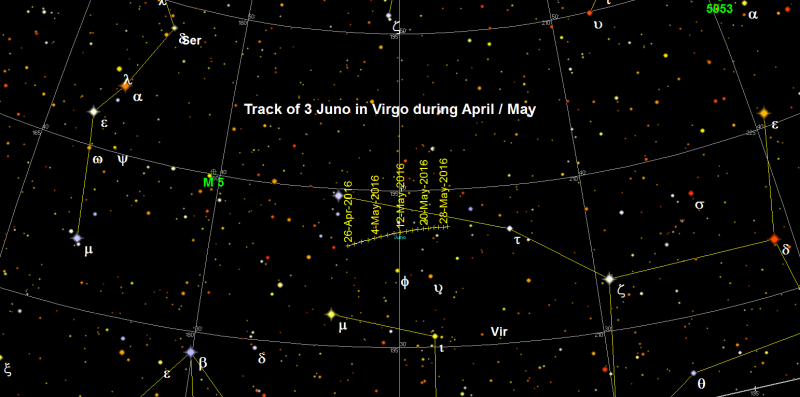2016 April 23
3 Juno at opposition
Asteroid 3 Juno reaches opposition in Vigo on April 27 and so is well placed for observation around that date. Not as bright as it can be at some oppositions (it only reaches magnitude 10 this time) it will still be a relatively easy object in medium sized telescopes, although its motion against the background stars will be very small. Photographers have the best chance of locating it by imaging the area on a night by night basis.
Main belt asteroid 3 Juno (the third asteroid to be discovered, hence the 3) was discovered by the German astronomer Karl Ludwig Harding on 1804 Sept 1. At the time it was lying in Aquarius at magnitude 8.2, so considerably brighter than it is currently. 1 Ceres, the first asteroid to be discovered, was picked up by Giuseppe Piazzi on 1801 January 1 (also at magnitude 8.2) and 2 Pallas by Heinrich Olbers (of paradox fame) on 1802 March 28 (at magnitude 8.1).
3 Juno is an S class (stony) asteroid and one of the largest and brightest in its class. It also has the distinction of being the first asteroid for which an occultation was observed (in 1958). Juno has an orbital period of 4.36 years, a rotation period of 7.21 hours and an estimated diameter of 234km.
The track of 3 Juno is shown on the chart below. For those people using go-to telescopes finding Juno should be an easy task, but for those people using setting circles its position at opposition and just after is as follows:
April 27 22:00 UTC RA 14h 41m 2.0s Dec -1 deg 3 min 25 sec
April 28 22:00 UTC RA 14h 40m 13.8s Dec -0 deg 57 min 33 sec
April 29 22:00UTC RA 14h 39m 25.4s Dec -0 deg 51 min 47 sec
April 30 22:00UTC RA 14h 38m 37.0s Dec -0 deg 46 min 7 sec
For star hoppers who like a challenge, on opposition night Juno is 3 degrees 13 arcmin SSW of mag 3.7 star 109 Virginis. Also nearby is asteroid 42 Isis, at magnitude 10.7.

| The British Astronomical Association supports amateur astronomers around the UK and the rest of the world. Find out more about the BAA or join us. |
